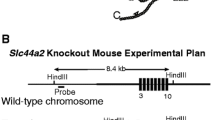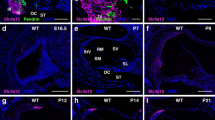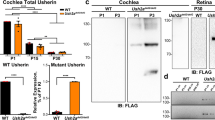Abstract
GJB2 gene mutations are the most common causes of autosomal recessive non-syndromic hereditary deafness. For individuals suffering from severe to profound GJB2-related deafness, cochlear implants have emerged as the sole remedy for auditory improvement. Some previous studies have highlighted the crucial role of preserving cochlear neural components in achieving favorable outcomes after cochlear implantation. Thus, we generated a conditional knockout mouse model (Cx26-CKO) in which Cx26 was completely deleted in the cochlear supporting cells driven by the Sox2 promoter. The Cx26-CKO mice showed severe hearing loss and massive loss of hair cells and Deiter’s cells, which represented the extreme form of human deafness caused by GJB2 gene mutations. In addition, multiple pathological changes in the peripheral auditory nervous system were found, including abnormal innervation, demyelination, and degeneration of spiral ganglion neurons as well as disruption of heminodes in Cx26-CKO mice. These findings provide invaluable insights into the deafness mechanism and the treatment for severe deafness in Cx26-null mice.







Similar content being viewed by others
Data Availability
The datasets generated during and/or analyzed during the current study are available from the corresponding author upon reasonable request.
References
Qiu Y, Zheng J, Chen S, Sun Y. Connexin mutations and hereditary diseases. Int J Mol Sci 2022, 23: 4255.
Hosoya M, Fujioka M, Murayama AY, Ogawa K, Okano H, Ozawa H. Dynamic spatiotemporal expression changes in connexins of the developing primate’s cochlea. Genes (Basel) 2021, 12: 1082.
Lautermann J, ten Cate WJF, Altenhoff P, Grümmer R, Traub O, Frank HG. Expression of the gap-junction connexins 26 and 30 in the rat cochlea. Cell Tissue Res 1998, 294: 415–420.
Liu W, Li H, Edin F, Brännström J, Glueckert R, Schrott-Fischer A, et al. Molecular composition and distribution of gap junctions in the sensory epithelium of the human cochlea-a super-resolution structured illumination microscopy (SR-SIM) study. Ups J Med Sci 2017, 122: 160–170.
Liu W, Edin F, Blom H, Magnusson P, Schrott-Fischer A, Glueckert R, et al. Super-resolution structured illumination fluorescence microscopy of the lateral wall of the cochlea: the Connexin26/30 proteins are separately expressed in man. Cell Tissue Res 2016, 365: 13–27.
Kenna MA, Feldman HA, Neault MW, Frangulov A, Wu BL, Fligor B, et al. Audiologic phenotype and progression in GJB2 (Connexin 26) hearing loss. Arch Otolaryngol Head Neck Surg 2010, 136: 81–87.
Shearer AE, Hildebrand MS, Smith RJ. Hereditary hearing loss and deafness overview. In: Adam MP, Ardinger HH, Pagon RA, Wallace SE, Bean LJ, Stephens K, editors. Gene Review. Seattle (WA): University of Washington; 1993–2018.
Takada Y, Beyer LA, Swiderski DL, O’Neal AL, Prieskorn DM, Shivatzki S, et al. Connexin 26 null mice exhibit spiral ganglion degeneration that can be blocked by BDNF gene therapy. Hear Res 2014, 309: 124–135.
Shearer AE, Eppsteiner RW, Frees K, Tejani V, Sloan-Heggen CM, Brown C, et al. Genetic variants in the peripheral auditory system significantly affect adult cochlear implant performance. Hear Res 2017, 348: 138–142.
Wu CM, Ko HC, Tsou YT, Lin YH, Lin JL, Chen CK, et al. Long-term cochlear implant outcomes in children with GJB2 and SLC26A4 mutations. PLoS One 2015, 10: e0138575.
Barclay M, Ryan AF, Housley GD. Type I vs type II spiral ganglion neurons exhibit differential survival and neuritogenesis during cochlear development. Neural Dev 2011, 6: 33.
Huang LC, Thorne PR, Housley GD, Montgomery JM. Spatiotemporal definition of neurite outgrowth, refinement and retraction in the developing mouse cochlea. Development 2007, 134: 2925–2933.
Rubel EW, Fritzsch B. Auditory system development: Primary auditory neurons and their targets. Annu Rev Neurosci 2002, 25: 51–101.
Panganiban CH, Barth JL, Darbelli L, Xing Y, Zhang J, Li H, et al. Noise-induced dysregulation of Quaking RNA binding proteins contributes to auditory nerve demyelination and hearing loss. J Neurosci 2018, 38: 2551–2568.
Wan G, Corfas G. Transient auditory nerve demyelination as a new mechanism for hidden hearing loss. Nat Commun 2017, 8: 14487.
Qing Chang. Timed conditional null of connexin26 in mice reveals temporary requirements of connexin26 in key cochlear developmental events before the onset of hearing. Neurobiol Dis 2015, 73: 418–427.
Chen S, Sun Y, Lin X, Kong W. Down regulated connexin26 at different postnatal stage displayed different types of cellular degeneration and formation of organ of Corti. Biochem Biophys Res Commun 2014, 445: 71–77.
Kudo T, Kure S, Ikeda K, Xia AP, Katori Y, Suzuki M, et al. Transgenic expression of a dominant-negative connexin26 causes degeneration of the organ of Corti and non-syndromic deafness. Hum Mol Genet 2003, 12: 995–1004.
Chen S, Xie L, Xu K, Cao HY, Wu X, Xu XX, et al. Developmental abnormalities in supporting cell phalangeal processes and cytoskeleton in the Gjb2 knockdown mouse model. Dis Model Mech 2018, 11: dmm033019.
Liu XZ, Jin Y, Chen S, Xu K, Xie L, Qiu Y, et al. F-actin dysplasia involved in organ of corti deformity in Gjb2 knockdown mouse model. Front Mol Neurosci 2021, 14: 808553.
Amor V, Feinberg K, Eshed-Eisenbach Y, Vainshtein A, Frechter S, Grumet M, et al. Long-term maintenance of Na+ channels at nodes of Ranvier depends on glial contact mediated by gliomedin and NrCAM. J Neurosci 2014, 34: 5089–5098.
Chen P, Wu W, Zhang J, Chen J, Li Y, Sun L, et al. Pathological mechanisms of connexin26-related hearing loss: Potassium recycling, ATP-calcium signaling, or energy supply? Front Mol Neurosci 2022, 15: 976388.
Walters BJ, Yamashita T, Zuo J. Sox2-CreER mice are useful for fate mapping of mature, but not neonatal, cochlear supporting cells in hair cell regeneration studies. Sci Rep 2015, 5: 11621.
Zhu Y, Liang C, Chen J, Zong L, Chen GD, Zhao HB. Active cochlear amplification is dependent on supporting cell gap junctions. Nat Commun 2013, 4: 1786.
Froud KE, Wong AC, Cederholm JM, Klugmann M, Sandow SL, Julien JP, et al. Type II spiral ganglion afferent neurons drive medial olivocochlear reflex suppression of the cochlear amplifier. Nat Commun 2015, 6: 7115.
Acknowledgments
We are grateful to the Center for Instrumental Analysis and Metrology, the Institute of Virology, and the Chinese Academy of Science, for the electron microscopy (EM), and thank An-Na Du and Ding Gao for their help with the EM experiments. This work was supported by the National Key Research and Development Program of China (2021YFF0702303) and the National Natural Science Foundation of China (82301324, 82301323, and 82071058).
Author information
Authors and Affiliations
Corresponding authors
Ethics declarations
Conflict of interest
The authors declare no conflict of interest.
Rights and permissions
Springer Nature or its licensor (e.g. a society or other partner) holds exclusive rights to this article under a publishing agreement with the author(s) or other rightsholder(s); author self-archiving of the accepted manuscript version of this article is solely governed by the terms of such publishing agreement and applicable law.
About this article
Cite this article
Qiu, Y., Xie, L., Wang, X. et al. Abnormal Innervation, Demyelination, and Degeneration of Spiral Ganglion Neurons as Well as Disruption of Heminodes are Involved in the Onset of Deafness in Cx26 Null Mice. Neurosci. Bull. (2024). https://doi.org/10.1007/s12264-023-01167-x
Received:
Accepted:
Published:
DOI: https://doi.org/10.1007/s12264-023-01167-x




